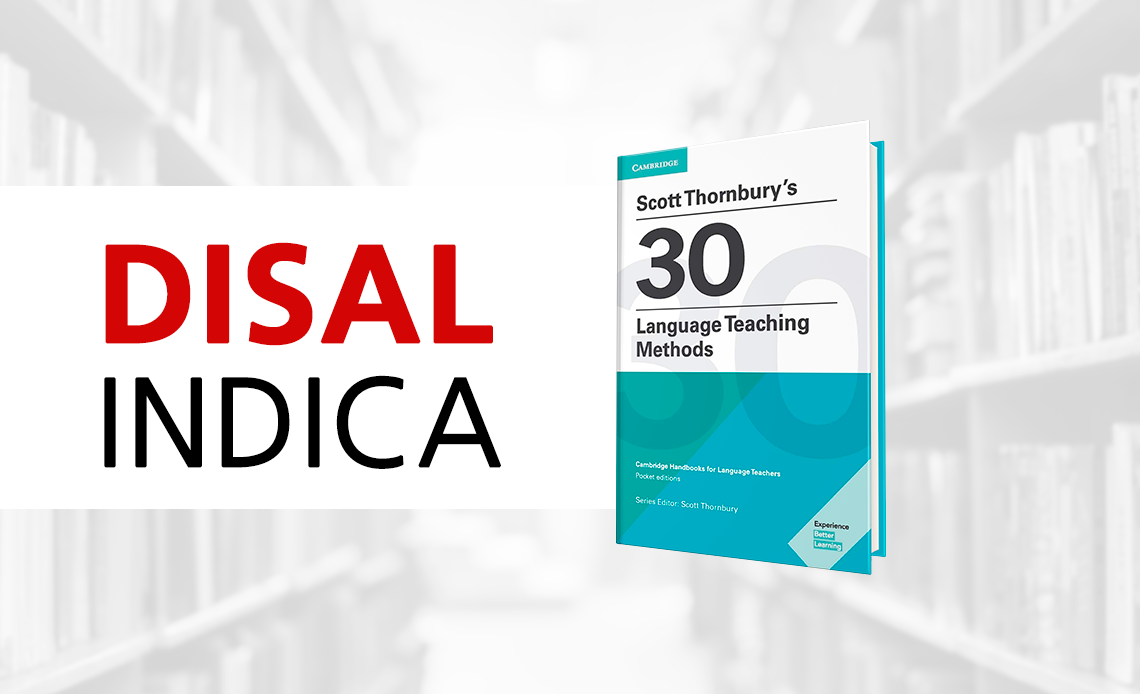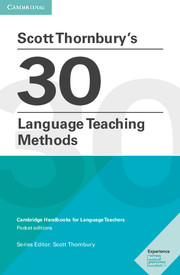
Book review by Mark Rooney
As he draws his book to a close, Scott Thornbury states the following, ‘at the very least, the principled teacher should be able to respond to the question “why did you do that?”’ This question is too rarely asked of language teachers. Our daily practice is often so concerned with the ‘how’ of teaching that we neglect to ask ‘why?’. For those who would like to address this imbalance, 30 Language Teaching Methods is certainly a good place to start.
The book is one in a series of Cambridge Handbooks for Language Teachers: Pocket editions. The aim is to deliver shorter, and by their own admission, ‘less comprehensive’ explorations of topics and practices that should be relevant to all language teachers. They are called pocket editions for a reason. This one weighs in at 120-odd pages and is both light and portable. In fact, this lack of mass is one of the book’s greatest appeals. It is not a tome that requires you to unpack each method in laborious detail. Rather, it presents an unintimidating overview of numerous methodologies that have had a significant influence on language teaching.
As the title suggests, 30 language teaching methods are examined in the book. The language teaching canon is given a good airing, with methods such as Grammar Translation, the Direct Method, and Task Based Learning all explored. There are also some less canonical methods included, such as Crazy English or more contemporary movements like Programmed Instruction. The book, however, is not a chronological history of language teaching methodologies. Instead, Thornbury chooses to group methods by what they have in common. Therefore, we find numerous methods grouped into categories such as Natural Methods, Communicative Methods or Visionaries.
Each brief chapter dissects one method by looking at four key questions. Firstly, Thornbury explores the background of the method: its historical context and some of its early proponents. Then he asks; how does it work? In doing so, he lays out the ways each method might manifest itself in our classroom practice. This is followed by the fundamental question; does it work? Here Thornbury attempts to lay out the evidence for and against each method based on research and practice (spoiler alert – there is no best method). Finally, he asks; what’s in it for us? This section allows us to consider whether a method, or more likely, aspects from different methods, can be integrated into our practice.
A fair question for teachers to ask is: why should I read this book? For me, there are two convincing answers. The first is that it challenges the reader to ask meaningful questions of themselves. Teachers who approach this book with an open mind are likely to spend at least some time reckoning with their own beliefs about teaching. As they evaluate different theories, they should see their own behaviour represented on the page. They are also likely to see themselves in more than one method, including those which they may be less enthusiastic about. For any developing teacher these are valuable observations. To realise that your practice is a product of history, that your beliefs come from somewhere outside your own thinking, can have a validating effect. It may give the insecure teacher greater confidence. There is reassurance in knowing that you are not the first person to stumble over seemingly intractable problems; instead you are the latest to walk on well-trodden ground. For others, meanwhile, the book may have an unnerving effect. For instance, teachers who have become completely wedded to a particular belief may not like some of Thornbury’s answers when he questions the efficacy of certain methods. He is somewhat wary of the bigger claims made by different methods. This uncertainty might sow some doubt in the minds of teachers with entrenched views. However, it is this doubt that is often the catalyst for change and development.
The second convincing answer is that the book encourages the reader to have a more comprehensive understanding of their profession. When you have been teaching for long enough, you start to notice the cyclical nature of trends in education. A book like 30 Language Teaching Methods perfectly captures this cycle. We observe which ideas have come and gone, and which ones have come round again. By categorising 30 methods into five broad categories, it becomes apparent that we are still puzzled by the same issues that language teachers were grappling with over a century ago. This is not to say that Thornbury suggests that all methods are alike and all our efforts have been in vain. Rather by grouping similar methods together, we should notice the subtle differences between them. This is, again, instructive. It allows us to observe how our predecessors have attempted to solve complex problems with nuanced solutions. In fact, this is the very kind of thinking the book promotes: that the language teacher’s task is to reflect more deeply, more often, and with greater sophistication about what is happening in their classroom. In order to do so, they will be best equipped if they have at least a rudimentary knowledge of what has gone before them. This book may lead them to that place. (Modern English Teacher, 2017).
List of contents
https://assets.cambridge.org/97811084/08462/toc/9781108408462_toc.pdf
Frontmatter
https://assets.cambridge.org/97811084/08462/frontmatter/9781108408462_frontmatter.pdf
About the author
He is a teacher and teacher educator, with over 30 years’ experience in English language teaching, and an MA from the University of Reading. His previous experience includes teaching and teacher training in Egypt, UK, Spain (where he lives), and in his native New Zealand. His writing credits include several award-winning books for teachers on language and methodology, as well as authoring a number of papers and book chapters on language and language teaching. He is series editor for the Cambridge Handbooks for Teachers (CUP). He was also the co-founder of the dogme ELT group (see Articles).
Books: http://www.scottthornbury.com/books.html
Articles: http://www.scottthornbury.com/articles.html
Talks: http://www.scottthornbury.com/talks.html
Videos: http://www.scottthornbury.com/videos.html
Blog: https://scottthornbury.wordpress.com/

Scott Thornbury’s very accessible 30 Teaching Methods, groups methods according to what they have in common, even if separated in time. At the same time, it rehabilitates some lost or forgotten methods, with a view to challenging current orthodoxies, especially with regard to such topics as translation, rote learning, authenticity, and communication. In doing this it aims to unpack, not just the history of methods, but the beliefs that underpin them and the benefits that still might possibly accrue from experimenting with them. Through its inclusion of interesting characters, intriguing anecdotes, and often bizarre techniques, the material is absorbing and engaging.
BIBLIOGRAFIA
Rooney, Mark. 30 Language Teaching Methods.Modern English Teacher, 2017. Disponível em: https://www.modernenglishteacher.com/30-language-teaching-methods. Acesso em: 13 de jul. de 2020.

